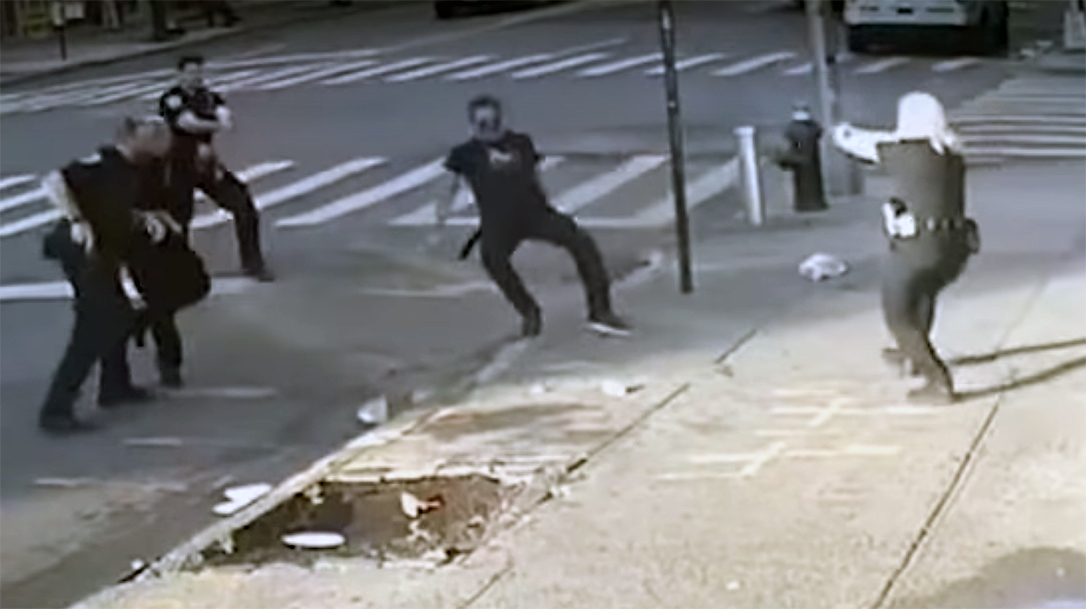Using video alone to critique law enforcement confrontations with dangerous suspects is not the same as watching game film. If a defender loses his mark on the soccer field and it results in a score, that’s cut and dry negligence. However, video alone cannot serve as definitive evidence of real-world, lethal encounters, including this interesting clip of NYPD officers taking on and eventually shooting a suspect — later identified as Peyman Bahadoran — armed with a knife June 4.
NYPD Officers Make Mistakes in Shooting
In this video we do not know why officers were entering this business. Were the officers responding to call about this suspect? Did he threaten officer No. 2 on entry, or did she question the knife on his side?
Advertisement — Continue Reading Below
We also do not know the standard operating procedures for the officers involved. Sometimes determining if an officer acted logically and within policy guidelines is not the same thing. Still, we can make some generalized assumptions and observations that, instead of serving as criticism of those involved, can be used as training notes for others.
For example, it’s obvious that officer No. 2 and the suspect are engaged in a verbal confrontation upon his entry into the business (3:34). Officer No. 1 seemingly ignores this, focused on letting the suspect’s dog inside (3:51). This prevented her from seeing the suspect draw the knife, to which officer No. 2 reacted by drawing her taser instead of her gun.
- Lesson 1: Be a good partner and pay attention to what matters.
- Lesson 2: Know when less-than-lethal tools should be used and understand the use of force continuum.
Don’t Leave Your Partner Hanging
While officer No. 2 was trying to distance herself from the suspect, officer No. 1 reached for her radio instead of her taser or gun (3:58). We have to assume she was calling for backup.
Advertisement — Continue Reading Below
- Lesson 3: Calling for backup is a good thing. It does not take precedence over dealing with an imminent dangerous threat.
It could be argued that once behind the counter (4:05), officer No. 2 had some cover and her choice not to shoot was reasonable. However, it appears the suspect was threatening to throw the knife (4:10), thus rendering the low cover worthless.
- Lesson 4: Suspect pulls a knife, in close proximity, and threatens … shoot the suspect.
Unfortunately, officer No. 1 — who ultimately perceived the suspect threatening enough to shoot — was not present to make that determination. She had stepped outside 10 seconds prior to adjust her mask, take a smoke break, or for some other inexplicable reason.
- Back to Lesson 1: Again, with feeling: be a good partner!
Clerk Stayed in the Fight
We have to give some kudos to the store clerk for disarming the suspect, and to the dog for not biting anyone on the ankle. But we have to wonder why officer No. 1 did not shoot the suspect when he was trying to disarm her (4:43). Instead, she chose to shoot him for pushing — or attempting to disarm — another officer (5:15); all this while she was delivering ear-splitting screams, and a fellow officer was directly in the line of fire (6:04). We could also point out the improper grip officer No. 1 had on her duty gun (6:07), but it did not seem to negatively affect her shooting.
Advertisement — Continue Reading Below
- Lesson 5: Panicked screaming < forceful voice commands.
- Lesson 6: Be aware of your target and what is beyond it.
It will be the totality of the circumstances that dictate whether the NYPD shooting was justified or not. Ultimately, several unanswered questions remain until the investigation is complete.
Editor’s Note: Richard Mann served as a police officer, tactical team member, special agent, and law enforcement, military and civilian small arms instructor. He also authored a book on training: Handgun Training for Personal Protection.























